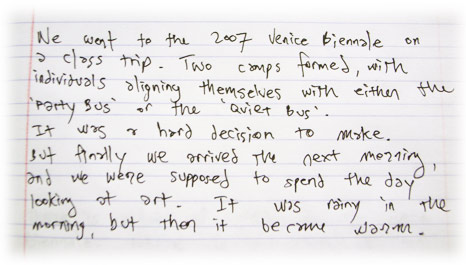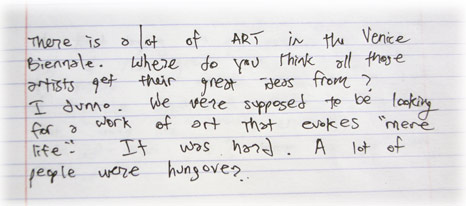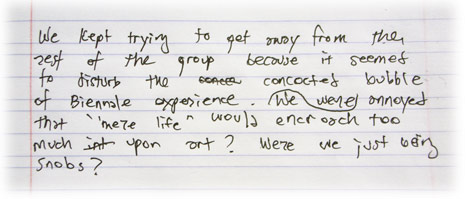The crux of this situation is one of returning to an academic reportage—after the holiday, after the event, after stepping out of the heretofore all-encompassing realm that is the Home and learning to tell or recount (and what not) to our classmates, our teachers, our friends. Spending the entire summer hanging out by the pool and eating sandwiches with the crusts cut off may have been real life. But how much of a real life do we access, relive, or reveal when writing about our experiences, passing them on to others, or trying to capture them via other media simultaneous to the experience (i.e., photographs, audio recording, drawing, etc.)? If we make art from/of our lives are the results still a reflection of the world we live in, and how much do we really reveal about ourselves through the process? More? Less? Is life as recorded in a journal, a newspaper, an uploaded video or a painting symmetrical to “mere life”? Or parallel?
 The question of life in art is not at least in part a question of reality and document, of truth and artifact. Insofar that life is being, it is the living element of a work of art, its energeia, which we recognise, or recognises us, is capable of moving us beyond our own mere lives towards truth and Heidegger’s sense of the world worlded, “more fully in being than the tangible and perceptible realm in which we believe ourselves to be at home.” To find, then, the evocation of life in the artwork does not set up a dichotomy as implied by the analogy of reality to document, truth to artifact. We can look perhaps more towards Adorno’s dialectics, not by way of simple polarities but a dialecticalism whereby one is contained in the other—art and life mutually inherent.
The question of life in art is not at least in part a question of reality and document, of truth and artifact. Insofar that life is being, it is the living element of a work of art, its energeia, which we recognise, or recognises us, is capable of moving us beyond our own mere lives towards truth and Heidegger’s sense of the world worlded, “more fully in being than the tangible and perceptible realm in which we believe ourselves to be at home.” To find, then, the evocation of life in the artwork does not set up a dichotomy as implied by the analogy of reality to document, truth to artifact. We can look perhaps more towards Adorno’s dialectics, not by way of simple polarities but a dialecticalism whereby one is contained in the other—art and life mutually inherent.![]() Even so, the “mere life” evoked in a work of art is by no means equal to reality. The distance between the two can be described as a greater truth or a place of the spirit, but perhaps, much less glamourously—not so far off from the gap between seeing someone’s endless vacation slideshow versus having been part of the real experience. One approaches a higher plane of being, the other is, very often, just a bore.
Even so, the “mere life” evoked in a work of art is by no means equal to reality. The distance between the two can be described as a greater truth or a place of the spirit, but perhaps, much less glamourously—not so far off from the gap between seeing someone’s endless vacation slideshow versus having been part of the real experience. One approaches a higher plane of being, the other is, very often, just a bore. At the Biennale di Venezia, a near Disneyland of contemporary art and national identity, we are afforded the small world after all of contemporary art multiculturalism. The short examples following interest me here as different national perceptions positioning life relative to art. The stereotypes that emerge are perhaps an ironically self-conscious colouring of the ways the simulacra overtakes us even in self-presentation, but at the current stage of hyper visual culture, it is possible in this context to raise new questions regarding art as presentation (show, artifact, material, object) versus documentation (alternate reality, report, medium, subject).
At the Biennale di Venezia, a near Disneyland of contemporary art and national identity, we are afforded the small world after all of contemporary art multiculturalism. The short examples following interest me here as different national perceptions positioning life relative to art. The stereotypes that emerge are perhaps an ironically self-conscious colouring of the ways the simulacra overtakes us even in self-presentation, but at the current stage of hyper visual culture, it is possible in this context to raise new questions regarding art as presentation (show, artifact, material, object) versus documentation (alternate reality, report, medium, subject).![]() Japan, History and Tradition.The most physically direct form of document was created by artist Masao Okabe for the Japan pavilion. His work consisted of a series of 1,400 frottages made with pencil on paper, rubbed directly on the surface of stones that made up the World War II bombed platforms of the former Ujina train station in Hiroshima. Okabe’s work is a document of history, a literal tracing of stone as the ultimate testament to the fragilities wrought by war, where even rock is impermanent, its solidity transferred into the grainy shades produces by a sketch, no more certain than the dead flowers and leaves pressed under glass throughout the installation. His is a document of “mere life” in its most physical approach, but its results question the viability of history via transference across artifact, time and medium.
Japan, History and Tradition.The most physically direct form of document was created by artist Masao Okabe for the Japan pavilion. His work consisted of a series of 1,400 frottages made with pencil on paper, rubbed directly on the surface of stones that made up the World War II bombed platforms of the former Ujina train station in Hiroshima. Okabe’s work is a document of history, a literal tracing of stone as the ultimate testament to the fragilities wrought by war, where even rock is impermanent, its solidity transferred into the grainy shades produces by a sketch, no more certain than the dead flowers and leaves pressed under glass throughout the installation. His is a document of “mere life” in its most physical approach, but its results question the viability of history via transference across artifact, time and medium.![]() France, Love.Sophie Calle’s work can also be said to be evocative of “mere life” in the sense that it is largely autobiographical, and the source of her piece for the French pavilion is no exception, although this time Calle succeeds in moving her story outside of her own life and recapturing it through others— 107 other women, precisely. By asking each of the participants to translate, interpret or explain a break-up letter received from her lover, Calle is able to create a prism of images of the lives and perspectives of these women, revoiced in the form of dance numbers, linguistic corrections and psychological diagnoses among others. Insodoing, the acuteness of a supposedly ‘real’ emotional situation becomes estranged, dramatised and made multiplicitous. “Mere life” is simply a matter of perspective.
France, Love.Sophie Calle’s work can also be said to be evocative of “mere life” in the sense that it is largely autobiographical, and the source of her piece for the French pavilion is no exception, although this time Calle succeeds in moving her story outside of her own life and recapturing it through others— 107 other women, precisely. By asking each of the participants to translate, interpret or explain a break-up letter received from her lover, Calle is able to create a prism of images of the lives and perspectives of these women, revoiced in the form of dance numbers, linguistic corrections and psychological diagnoses among others. Insodoing, the acuteness of a supposedly ‘real’ emotional situation becomes estranged, dramatised and made multiplicitous. “Mere life” is simply a matter of perspective.![]() China, Future. Cao Fei’s use of the internet portal Second Life to create her video installation for the Chinese pavilion brings ‘reality’ directly into the art world, as it investigates a phenomenon that is transpiring in the immediate present, being translated across media from a virtuality through the internet to a mass phenomenon, not necessarily in terms of users but certainly by press coverage. The irony and fascination that Second Life poses for both Cao and the media is that the form of reality proposed by it is one that projects itself as a future for everyone, and the ambivalent possibilities proffered by this future are ones that reacts back upon the present of our “mere” everyday realities. Her documentary made entirely from footage of the voyages of her Second Life avatar, China Tracy, turn the strangely connected but utterly desolate world before us into a montage of cinematic moments, like nostalgic flashbacks of something not yet experienced.
China, Future. Cao Fei’s use of the internet portal Second Life to create her video installation for the Chinese pavilion brings ‘reality’ directly into the art world, as it investigates a phenomenon that is transpiring in the immediate present, being translated across media from a virtuality through the internet to a mass phenomenon, not necessarily in terms of users but certainly by press coverage. The irony and fascination that Second Life poses for both Cao and the media is that the form of reality proposed by it is one that projects itself as a future for everyone, and the ambivalent possibilities proffered by this future are ones that reacts back upon the present of our “mere” everyday realities. Her documentary made entirely from footage of the voyages of her Second Life avatar, China Tracy, turn the strangely connected but utterly desolate world before us into a montage of cinematic moments, like nostalgic flashbacks of something not yet experienced. Why am I writing this again?
Why am I writing this again?![]() Oh yes, Biennale experience. Mere life.
Oh yes, Biennale experience. Mere life.![]() Is it a coincidence that this question of mere life is actually one of the primary themes of this year’s Documenta exhibition? Perhaps we should look outside of the context of a self-inflated art exhibition towards another, slightly-less-self-inflated-but-on-the-Grand-Tour-nonetheless art exhibition to get back to this question of mere life.
Is it a coincidence that this question of mere life is actually one of the primary themes of this year’s Documenta exhibition? Perhaps we should look outside of the context of a self-inflated art exhibition towards another, slightly-less-self-inflated-but-on-the-Grand-Tour-nonetheless art exhibition to get back to this question of mere life.![]() Or, perhaps mere life is merely in the looking.
Or, perhaps mere life is merely in the looking.![]() I’ll let you know after we get to Kassel.
I’ll let you know after we get to Kassel.

first of all, thank you for writing this piece. i’ve come to believe a work of art, if it is not artificiality, can always offer viewers a sneak peak into the artist’s life. but of course, when artificiality is all the rage, i have no ability to judge. what is art then?